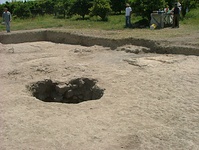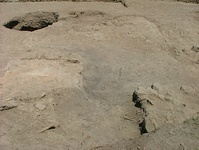| Collection: | Corinth | |
| Type: | Basket | |
| Name: | Nezi Field, context 51 | |
| Area: | Nezi Field | |
| Title: | Destruction debris: tile scatter. | |
| Category: | Deposit | |
| Notebook: | 1100 | |
| Context: | 51 | |
| Page: | 0 | |
| Date: | 2007/04/26 | |
| Stratum: | Inclusions 70%: *lots* of tile, pottery, stone (cobbles, coarse pebbles, medium pebbles), bone, shell, unworked marble, roots (in area closest to tree pit B7/B10). | |
| Description: | Top slope of the context is level. Bottom slope of the context is level down to the The soil color is dark yellowish brown. The soil compaction is very soft. The soil is very poorly sorted. It is sandy silt. | |
| Notes: | Covered by mostly B23 but also some B30 at N. end and B27 at E. end of scatter. There are more types of tiles than seem appropriate for one structure--perhaps they are reused from several different original sources? There is another level of tiles below those visible on the surface. The tiles are like a crust above the clayey deposit on which they rest, which is also visible to the N. underneath ash deposit B49, and maybe also the black soil (ash?) visible to the S. on the other side of the 'potting installation'--the orange clay feature and NW of the the S. end of the tile scatter in S. extension (these tiles are B58). The tiles overlie the NE corner of the stone enclosing the orange clay feature. Some tiles have been kept as examples if well-preserved and relatively intact (most are just bits and pieces). B29 was recorded as having disturbed the tile scatter-- Need to excavate more, closer to pit (cut of pit = B71), to see how tile scatter related to pit and B49 ash deposit--do they cut the tile scatter or does the tile scatter end somewhat S. of these deposits? G. Sanders came by and he believes the tile scatter may have been inside of and is now indicative of some sort of enclosure. The overall shape (minus later cuts and disturbances) is rather rectilinear. May there be a robbing trench to E. side of the tile scatter? There are some stones in vaguely linear arrangement in situ (but they don't look wall-like as they are not well-founded). The clay surface under the tiles has more ash(?) on it to the E. and slightly NE of the orange clay feature. Several fragments of pebble-pressed floor found not in situ. The depth of B51 is much shallower at W. by pit and to S. of B49. It seems like the soil deposit that contains the tiles does underlie B49 at the lower extent of B49, but it abuts B49 on its E. side. There are more tiles stuck into the clay below B51 as if pressed there either by destruction or as if they were part of a floor surface; they are not part of B51 and are laying flat in the orange clay below B51. The tiles in the S. extenstion will be treated as a separate basket (B58) because there are more, larger stones and the tiles do not now appear to rest on the same clay (according to the pickman, Bill)--this remains to be seen. The excavation of B51 has been halted at its NW extent between the pit with fill B36 at top and tree pit B7/B10 because the concentration of tiles has ended, though the pickman, Bill, says the soil is the same as what the tiles were resting in. It seems harder to me, but that could be because it is more dried out as it has been sitting in the sun awhile. B51 extended over the E. border of the orange-clay feature (see plan). B51 most properly = B59, because in both of these deposits the tiles were lying flat on the clay surface. In B58, above B59, the tiles were more churned up and less concentrated. But all three baskets were deposited at the same time. | |
| Context Pottery: | Fineware. metallic ware, unslipped (1275-1335), bowl. 1 rim. ; Fineware. glaze painted IV, slipped (1220-1260)2 bodysherds. ; Fineware. late sgraffito, slipped style VII (1250-1300)1 rim. 4 bodysherds. ; Coarseware. gunsenin III amphora (1200-1300)1 handle. ; Fineware. pre-medieval6 bodysherds. ; Coarseware. matte painted, bowl. 1 bodysherd. ; Cooking ware. triangular rim stew pot (1100-1270)1 rim. ; Coarseware. matte painted, stamnos. 5 handles. 31 bodysherds. ; Fineware. metallic ware, unslipped (1275-1335), pitcher. 1 bodysherd. ; Fineware. early champs levee fine, slipped style VI (1170-1200); Fineware. Frankish incised1 rim. ; Fineware. zeuxippus sgraffito, slipped painted (1240-1260), bowl. 1 rim. ; Fineware. light on dark IV, slip painted (1225-1260)2 bodysherds. ; Fineware. other medieval18 bodysherds. ; Fineware. RMR, slipped (1275-1325), bowl. 1 rim. ; Cooking ware. vertical rim stewpot (1270-1320)9 rims. 6 handles. ; Fineware. protomaiolica, slipped (1260-1325), bowl. 1 bodysherd. ; Fineware. dark on light slip painted, slipped (1140-1180) | |
| Pottery Summary: | 45 frag(s) 0.64 kg. (0% saved) fineware. | |
| 406 frag(s) 4.73 kg. (0% saved) coarseware. | ||
| 151 frag(s) 1.54 kg. (0% saved) cooking ware. | ||
| Context Artifacts: | tile pre Medieval 1; shell lima 1; flooring Hellenistic 3; bronze frag incomplete flat folded twisted 2; tile Medieval 20; terracotta lamp candlestick glazed 1; bone unid including ovis, sus ca. 50; glass Roman 2 | |
| Period: | Frankish (1210-1458 AD) | |
| Chronology: | ca. 1260-1280 | |
| Grid: | 271-267.61E, 1002-1007.2N | |
| XMin: | 267.61 | |
| XMax: | 271 | |
| YMin: | 1002 | |
| YMax: | 1007.2 | |
| Site: | Corinth | |
| City: | Ancient Corinth | |
| Country: | Greece | |
| Masl: | 87.47-87.67m. | |
| Is Above: | 74 | |
| Is Below: | 23 | |
| References: | Report: Nezi Field 2007 by Lydia Herring, Josh Langseth, Kris Lorenzo (2007-04-09 to 2007-05-18) Report: Nezi Field 2007 by Lydia Herring, Josh Langseth, Kris Lorenzo (2007-04-09 to 2007-04-27) Images (8) |
|
Classifications Sign in Provide feedback |
|


